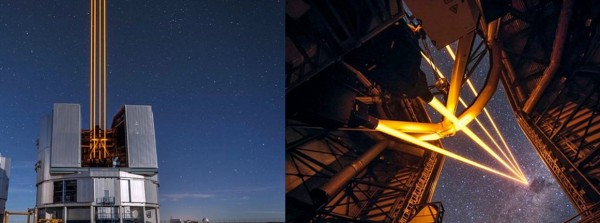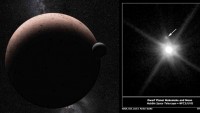Death Star-like Lasers for Astronomers' Use Fired for the First Time
| Arthur Dominic Villasanta | | Apr 28, 2016 07:28 PM EDT |
(Photo : ESO) Four Star Laser Guide Facility lasers firing into the sky in Chile
Looking more like the Death Star's planet-killing weapon than tools for astronomy, the four powerful lasers of the Very Large Telescope (VLT) at the Paranal Observatory in Chile were fired for the first time into the star studded sky on April 26.
The battery of four 22 Watt lasers goes by the name, "Four Laser Guide Star Facility" (4LGSF). It's a component of the adaptive optics system of the VLT operated by the European Southern Observatory.
Like Us on Facebook
The job of the four lasers that fire four gold hued laser light beams (each 30 cm in diameter) into night sky is to create "artificial stars" that aid in accurately pointing of the VLT. Most other observatories that use lasers such as the Keck Observatory in Germany are equipped with only one laser. The VLT in Chile is the first observatory operating more than one laser.
The four laser beams produce four artificial stars by illuminating sodium atoms in the atmosphere at 90 km altitude. Once they hit the sodium atoms, the lasers make the atoms glow like artificial stars that serve as a reference for the VLT's adaptive optics system. The glow is caused by the sodium atoms re-emitting the laser light.
"The artificial stars allow the adaptive optics systems to compensate for the blurring caused by the Earth's atmosphere, so that the telescope can create sharp images," said ESO in a statement.
"Using more than one laser allows the turbulence in the atmosphere to be mapped in far greater detail, to significantly improve the image quality over a larger field of view.
The 4LGSF Laser System is based on a fiber Raman laser technology developed at ESO. The VLT with its 39 meter main mirror is "the world's biggest eye on the sky."
TagsFour Laser Guide Star Facility, very large telescope, European Southern Observatory, 22 Watt lasers
©2015 Chinatopix All rights reserved. Do not reproduce without permission
EDITOR'S PICKS
-

Did the Trump administration just announce plans for a trade war with ‘hostile’ China and Russia?
-

US Senate passes Taiwan travel bill slammed by China
-

As Yan Sihong’s family grieves, here are other Chinese students who went missing abroad. Some have never been found
-

Beijing blasts Western critics who ‘smear China’ with the term sharp power
-

China Envoy Seeks to Defuse Tensions With U.S. as a Trade War Brews
-

Singapore's Deputy PM Provides Bitcoin Vote of Confidence Amid China's Blanket Bans
-

China warns investors over risks in overseas virtual currency trading
-

Chinese government most trustworthy: survey
-

Kashima Antlers On Course For Back-To-Back Titles
MOST POPULAR
LATEST NEWS
Zhou Yongkang: China's Former Security Chief Sentenced to Life in Prison

China's former Chief of the Ministry of Public Security, Zhou Yongkang, has been given a life sentence after he was found guilty of abusing his office, bribery and deliberately ... Full Article
TRENDING STORY

China Pork Prices Expected to Stabilize As The Supplies Recover

Elephone P9000 Smartphone is now on Sale on Amazon India

There's a Big Chance Cliffhangers Won't Still Be Resolved When Grey's Anatomy Season 13 Returns

Supreme Court Ruled on Samsung vs Apple Dispute for Patent Infringement

Microsoft Surface Pro 5 Rumors and Release Date: What is the Latest?













